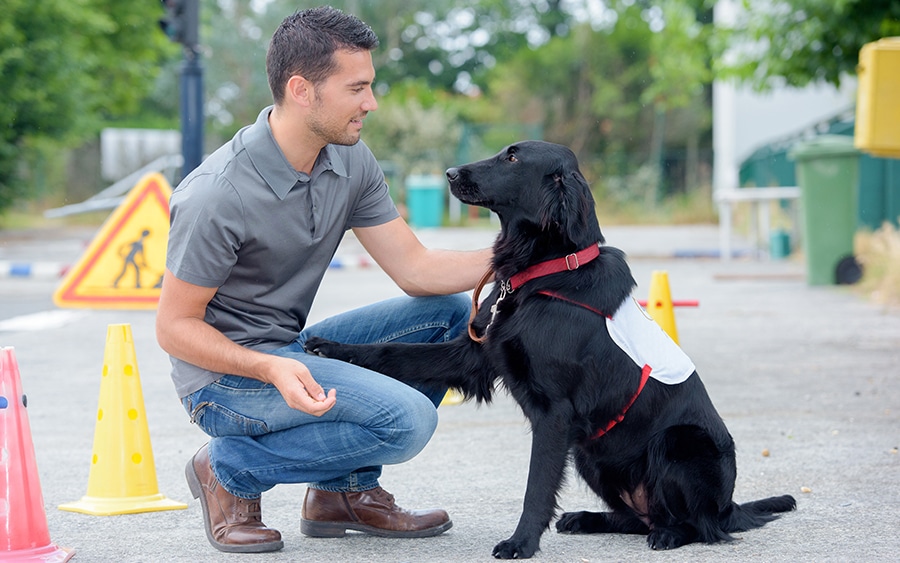The Ultimate Guide to Pet Dog Training: Building a Satisfied, Obedient Pet Dog
Efficient dog training is a diverse procedure that hinges on a deep understanding of canine actions and the application of proven methods. By embracing positive support and consistent command use, pet owners can grow not just obedience however also a solid, relying on relationship with their pets. The journey does not end with basic commands; addressing behavior concerns and developing a nurturing training setting are equally vital parts. As we explore these elements, it becomes apparent that the course to a mannerly and material canine buddy might hold a lot more intricacies than one could originally think.

Comprehending Canine Actions
Exactly how does a canine's actions show its emotional and psychological state? A dog's activities can work as a window right into its feelings, demands, and general psychological health. A wagging tail generally symbolizes happiness and exhilaration, while a lowered tail might suggest concern or entry. Articulations such as whimpering or barking can communicate a range of feelings, from joy to distress.
Body movement also plays a crucial function in recognizing canine behavior. An unwinded stance and open mouth signal comfort, whereas tense muscular tissues and pinned ears may suggest stress and anxiety or aggressiveness. Observing these signals is important for determining the origin of a dog's behavior, whether it comes from enjoyment, irritation, or anxiety.
In addition, a pet's communication with its setting and various other pets can give understanding right into its psychological state. A canine that engages happily with various other pet dogs is likely feeling safe and secure and social, while one that shows avoidance or aggression may be experiencing stress or instability. Comprehending these behavioral cues is essential for cultivating a solid connection between the proprietor and the family pet, inevitably contributing to the canine's psychological wellness and wellness.
Crucial Educating Methods
Efficient pet training techniques are crucial for promoting preferable habits and strengthening the bond in between a dog and its proprietor. Utilizing favorable support is one of one of the most effective approaches, where benefits such as deals with, praise, or play are given to enhance desired actions (Dog training). This motivates the dog to repeat those actions, producing a favorable knowing setting
Consistency is one more critical aspect in dog training. Commands need to be clear and uniform, and all member of the family need to use the same regulations to avoid puzzling the pet. Timing is similarly vital; incentives should be provided quickly after the preferred actions to develop a clear link between the action and the benefit.
Furthermore, brief and engaging training sessions work, as pets have differing attention spans. Objective for sessions of 5 to 15 minutes, relying on the dog's age and energy level. Incorporating play into training can likewise improve motivation and pleasure for both the pet dog and the proprietor.
Last but not least, patience is important. Pets find out at their very own rate, and keeping a tranquil temperament will certainly aid relieve aggravation, making certain a favorable training experience. These why not try these out essential techniques prepared for effective pet training and an unified relationship.
Basic Commands to Teach

Consistency and positive support are key when showing these commands. dog training charlotte nc. Use deals with, praise, and playtime to compensate your dog's successes. Short, regular training sessions are extra efficient than long, seldom ones. By instilling these fundamental commands, owners outfit their pet dogs with the abilities necessary for a unified and mannerly partnership.
Dealing With Common Behavioral Issues
Understanding and resolving usual behavior problems in canines is necessary for cultivating an unified partnership in between pet dogs and their proprietors. Several canines display habits such as too much barking, eating, or aggressiveness, which can stem from anxiety, boredom, or lack of appropriate training. Recognizing the source of these actions is the first action toward effective treatment.
For instance, excessive barking might indicate a demand for interest or a feedback to ecological stimuli. In such situations, proprietors must informative post evaluate the dog's setting and supply adequate psychological stimulation, such as interactive toys or normal exercise. Eating can usually be handled by redirecting the actions to proper eat things and guaranteeing that the pet has adequate exercise to minimize dullness.
Aggressive actions requires mindful handling and might require expert training help. It's essential to recognize that punishment can intensify anxiousness and aggression, bring about a cycle of behavior concerns. Instead, concentrate on favorable support techniques to award preferable actions and reinforce a sense of security.
Structure a Favorable Training Environment
Producing a favorable training environment is essential for enhancing desirable actions in canines and minimizing behavioral concerns. This setting should be defined by uniformity, encouragement, and a clear understanding of the training objectives. By establishing a regular, dogs learn what is expected of them, which assists lower stress and anxiety and complication.
Utilizing favorable support methods, such as treats, appreciation, and play, cultivates a sense of safety and inspiration in the canine. Rewarding etiquette immediately and constantly strengthens the wanted actions, making the training process much more efficient - Dog training. Additionally, trainers need read this article to continue to be person and calmness, as pet dogs are sensitive to their handlers' feelings
The training room must be complimentary from disturbances to make sure the pet can concentrate on the jobs at hand. Take into consideration making use of a peaceful room or a secure exterior location. Additionally, integrating playtime and socialization right into training sessions promotes an all-round method, enhancing the pet's knowing experience.
Inevitably, a positive training environment nurtures a solid bond between the dog and handler, leading to a loyal, happy pet dog. By prioritizing this atmosphere, pet owners can effectively attend to behavioral challenges and grow a successful training trip.
Final Thought
Efficient dog training depends on a comprehensive understanding of canine actions and the application of favorable support strategies. By grasping crucial commands and addressing behavioral problems with persistence and clear communication, owners can cultivate a strong bond with their pets. Developing an encouraging training atmosphere enhances safety and security and trust fund, eventually resulting in the growth of a cheerful and well-behaved buddy. Embracing these principles ensures a fulfilling training experience for both pet dogs and their owners.
Reliable pet training is a complex process that hinges on a deep understanding of canine behavior and the application of tested methods. A pet dog that involves happily with other canines is most likely sensation secure and social, while one that displays avoidance or aggressiveness might be experiencing anxiety or instability.Effective canine training techniques are important for promoting desirable behaviors and strengthening the bond in between a pet and its proprietor.Developing a favorable training setting is basic for enhancing preferable actions in pets and mitigating behavioral issues.Effective pet training depends on a detailed understanding of canine habits and the application of positive support techniques.
 Judge Reinhold Then & Now!
Judge Reinhold Then & Now! Seth Green Then & Now!
Seth Green Then & Now! Rachael Leigh Cook Then & Now!
Rachael Leigh Cook Then & Now! McKayla Maroney Then & Now!
McKayla Maroney Then & Now! Nicki Minaj Then & Now!
Nicki Minaj Then & Now!